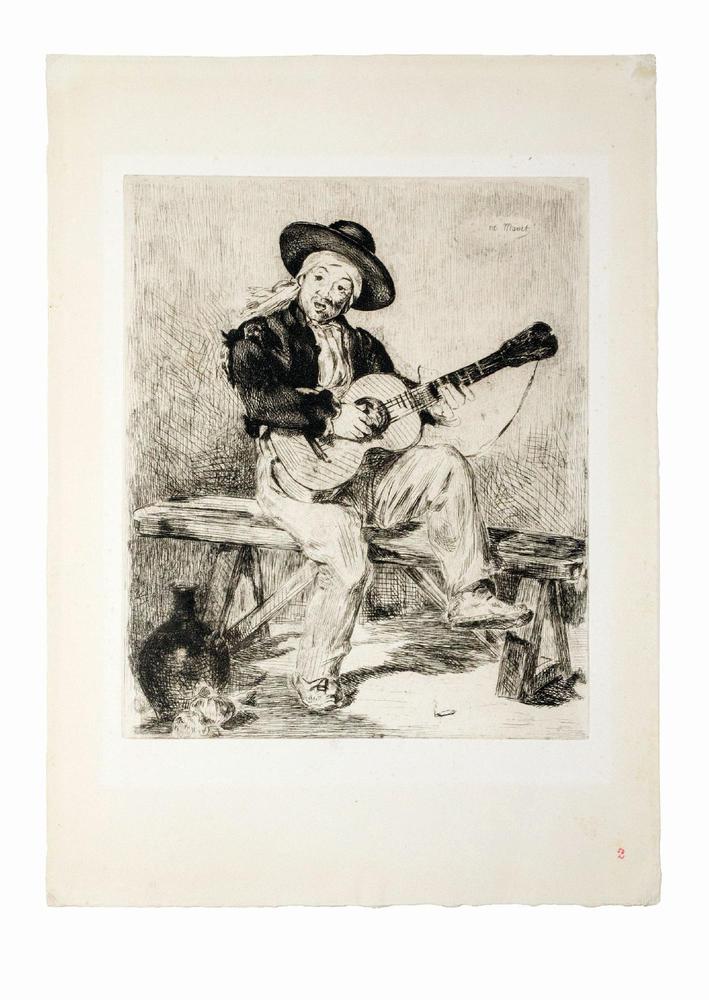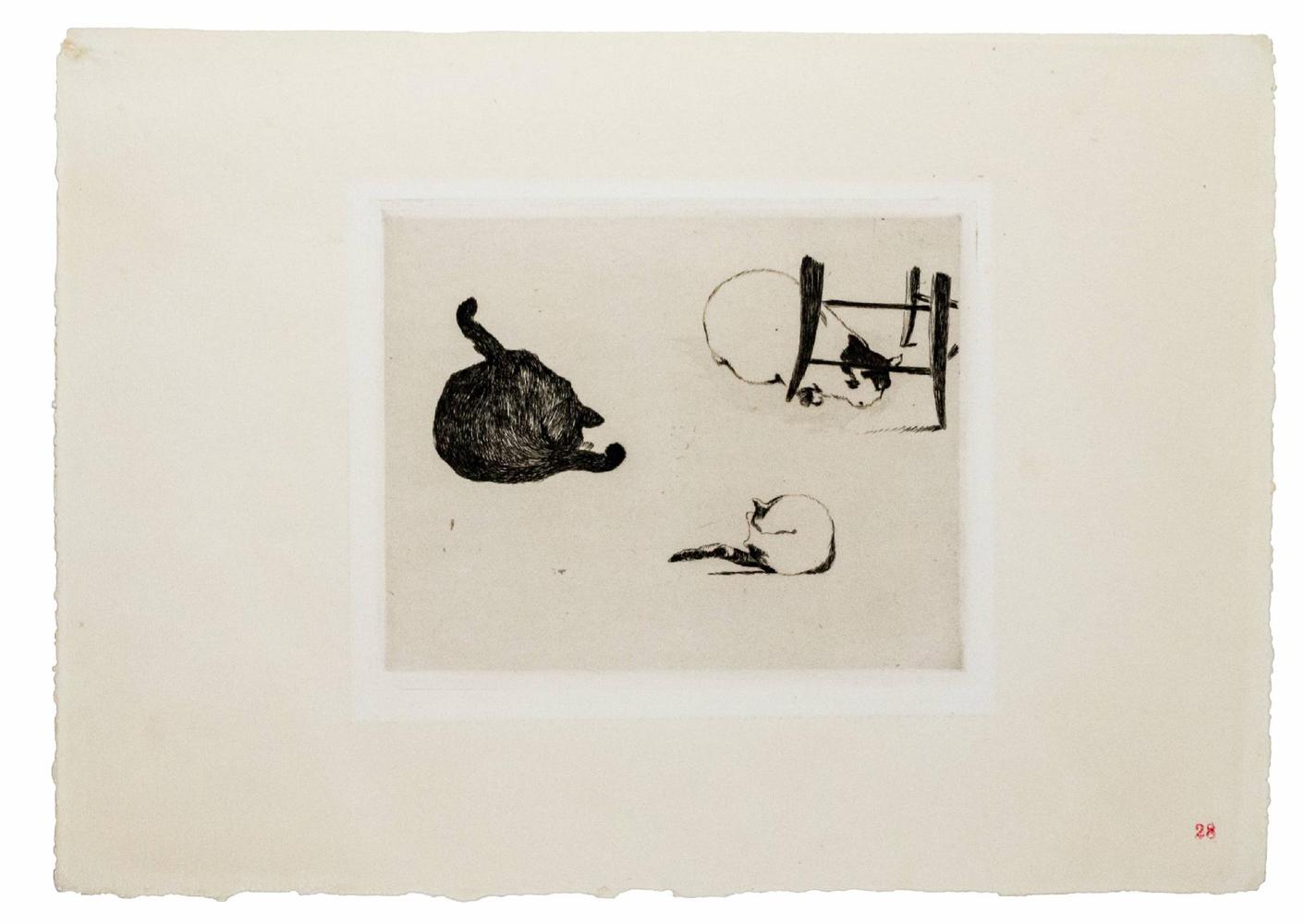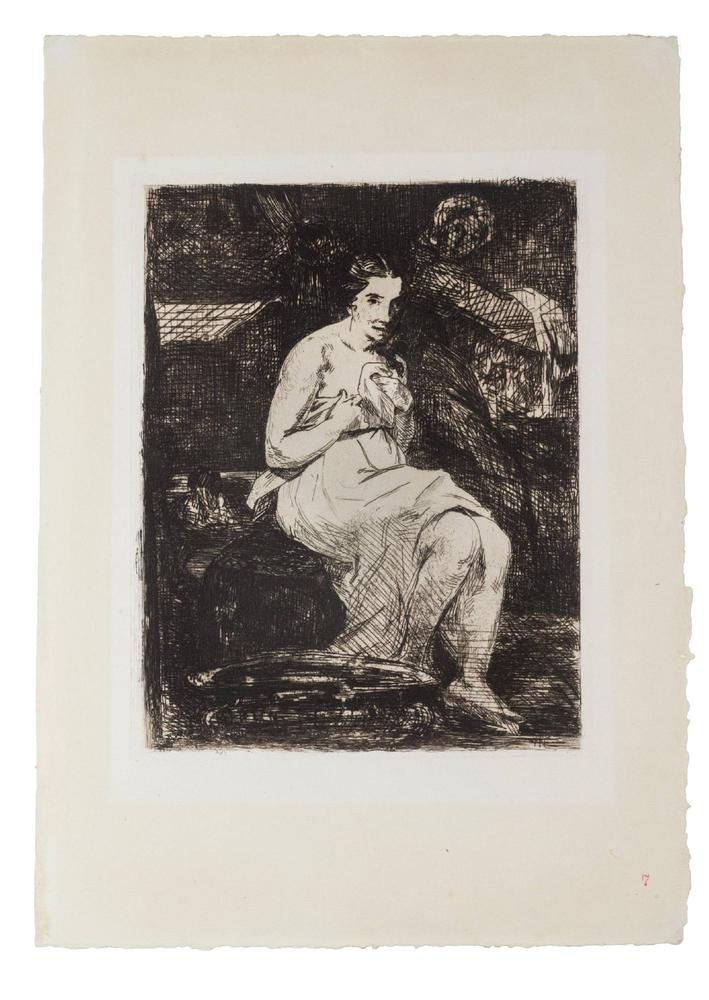Manet, Édouard (1832-1883). Manet. Trente eaux-fortes originales. Paris, A. Strölin, 1905.



Manet, Édouard (1832-1883). Manet. Trente eaux-fortes originales. Paris, A. Strölin, 1905.
Manet, Édouard (1832-1883).
Manet. Trente eaux-fortes originales.
Paris, A. Strölin, 1905.
Manet’s Etching Revival
Manet, Édouard (1832-1883).
Manet. Trente eaux-fortes originales. Paris, A. Strölin, 1905.
Large folio-size collection (546x360 mm) comprising a four-leaf booklet and complete set of thirty etchings with aquatint set in mats. The title-page includes a heliogravure portrait by Fantin-Latour; introduction and index by Théodore Duret. Edition of 100 copies. In original tan cloth portfolio case. Sheets with full margins, 445x312 mm; plates ranging in size. Printed on paper with the Van Gelder watermark or with crowned lily and monogram 'JGL'. In the lower right margin of each sheet is a small red editorial stamp with numbering of the plates. Good impressions, neatly inked and very fresh.
Exceedingly rare complete set of etchings with aquatint by the famous French artist Édouard Manet, the eldest son of an official in the French Ministry of Justice and a visionary Realist with a profound impact on Modern Art. Printed in Paris by the Swiss-born art dealer, publisher, and collector Alfred Strölin, the etchings are accompanied with an introduction and index by the French journalist, author, and art critic Théodore Duret, one of Manet's greatest champions, and a heliogravure portrait of Manet by Henri Fantin-Latour, an extraction from the latter's celebrated canvas, Hommage à Delacroix, which was exhibited at the Salon in 1864.
The early 1860s was a particularly fruitful time in Manet's career specifically and printmaking generally. As Duret explains, this was when the artist was most fascinated with Spanish themes, taking as his subjects the various singing and dancing troops that made their way into Parisian entertainment. In 1861, as a young artist of only twenty-nine years, Manet received honourable mention at the tremendously important Paris Salon with Le Guitarrero ('The Spanish Singer') followed by great notoriety at the 1863 Salon des Refusés with the scandalous Déjeuner sur l'herbe, a reputation perhaps most solidified when his Olympia was shown in 1865. In the same years, the 'Etching Revival' – a period from about 1850 to 1930 when the medium was re-embraced by artists, particularly in France, England, and the United States – was gaining speed thanks to the establishment of the Société des Aquafortistes in 1862. The Society, which aimed to promote etching among artists and the public alike, was established at the urging of the skilled etcher Alphonse Legros. As with other painters, Manet joined the Society new to the graphic arts, and it was Legros who taught him the ropes. Fittingly, among his earliest efforts counts an etching of Le Guitarrero, included here in its final state – a poetic testament to Manet's artistic and technical maturation.
Between 1860 and 1882, Manet produced about 100 prints (etchings and lithographs); although a number of these were included in Society-related projects, many others were published posthumously. Upon the artist's death in 1883, thirty etched plates were counted among his possessions, which then became the property of his wife, Suzanne; in 1890, Suzanne printed about thirty impressions of twenty-three of these (including thirteen which had previously been unpublished) at Gennevilliers, where Manet had summered at his family's house. These twenty-three plates, along with seven more, were then ceded to the dealer and printer Louis Dumont who likewise published thirty impressions of each of the thirty plates. As Dumont's successor, the plates then passed into the hands of Alfred Strölin, who is responsible for the current edition, of which 100 copies were printed. Apart from contemporary impressions known in only a small number of copies, the plates of the Strölin edition are generally considered most desirable, as those of previous editions are often poorly inked. There is, however, an additional measure of finality at play: upon completing the print run, Strölin destroyed all the coppers by punching holes in them, thus ensuring his would be the final prints pulled from Manet's plates.
The beautiful impressions included in Strölin's edition are representative of the vastness and depth of Manet's lauded career, ranging from his early investigations into Spanish themes to such famous masterpieces as Olympia (included here in two versions), and the portraits of Eva Gonzalès, Baudelaire (again in two versions), Berthe Morisot, and Edgar Allan Poe.
It is extremely rare to find the Strölin set complete with all thirty etchings along with the text.
E. Moreau-Nélaton, Manet, Graveur et Lithographe, Paris 1906; M. Guérin, L'Oeuvre gravé de Manet, Paris 1944; J. C. Harris, Edouard Manet: Graphic works, New York 1970; F. Cachin - C. S. Moffett - J. Wilson Bareau, Manet, 1832-1883: Galeries Nationales Du Grand Palais, Paris, April 22-August 8, 1983, the Metropolitan Museum of Art, New York, September 10-November 27, 1983, New York 1983; Philobiblon, One Thousand Years of Bibliophily, no. 280.


